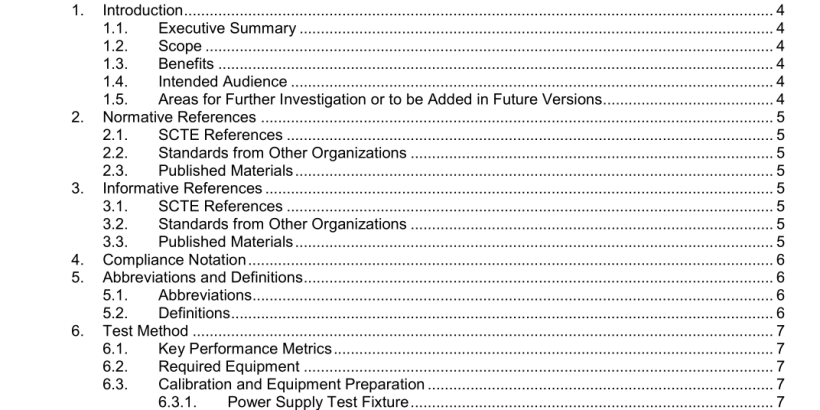ANSI SCTE 249-2018 pdf download.Test Method Common Mode Disturbance
1.1. Executive Summary
Common mode disturbance is generated by power electronics in all active devices. These are typically in the frequency range from 150 kHz to 30 MHz, though higher frequency disturbances are possible. These disturbances can be radiated and cause interference with wireless signals, or can become differential mode and be coupled into the upstream signal path of the cable plant, cause degradations to upstream signal-to-noise.
1.2. Scope
The purpose of this test is to determine the common mode disturbance generated by power electronics in active CPE equipment. Since conducted disturbances on the AC port is already a part of FCC testing requirements, this method focuses on measurements of the common mode disturbance on the coaxial port. Common mode disturbance from stand-alone power supplies are conducted through a common ground plane on the CPE device to the outer conductor of the coaxial port. Therefore stand-alone power supplies are also within the scope of this standard.
1.4. Intended Audience
The intended audience for this document are development engineers, quality assurance engineers, product managers, and technical operations engineers from both manufacturers and operators. Technicians and installers can benefit from this document as well to help troubleshoot issues in the field.
2. Normative References
The following documents contain provisions, which, through reference in this text, constitute provisions of this document. At the time of Subcommittee approval, the editions indicated were valid. All documents are subject to revision; and while parties to any agreement based on this document are encouraged to investigate the possibility of applying the most recent editions of the documents listed below, they are reminded that newer editions of those documents might not be compatible with the referenced version.
2.3. Published Materials
• No informative references are applicable.
3. Informative References
The following documents might provide valuable information to the reader but are not required when complying with this document.
3.1. SCTE References
• No informative references are applicable.
3.2. Standards from Other Organizations
• No informative references are applicable.
4. Compliance Notation
shall This word or the adjective “required” means that the item is an absolute requirement of this document. shall not This phrase means that the item is an absolute prohibition of this document. forbidden This word means the value specified shall never be used. should This word or the adjective “recommended” means that there may exist valid reasons in particular circumstances to ignore this item, but the full implications should be understood and the case carefully weighted before choosing a different course. should not This phrase means that there may exist valid reasons in particular circumstances when the listed behavior is acceptable or even useful, but the full implications should be understood and the case carefully weighed before implementing any behavior described with this label. may This word or the adjective “optional” means that this item is truly optional. One vendor may choose to include the item because a particular marketplace requires it or because it enhances the product, for example; another vendor may omit the same item. deprecated Use is permissible for legacy purposes only. Deprecated features may be removed from future versions of this document. Implementations should avoid use of deprecated features.
6.1. Key Performance Metrics
Common mode disturbance is measured against the following acceptance limits when
measured with a peak detector:
– No peaks above 45 dBµV from 10 MHz to 200 MHz
– No peaks above 74 dBµV to 64 dBµV, decreasing linearly with logarithm of frequency,from 150 kHz to 500 kHz
– No peaks above 64 dBµV from 500 kHz to 10 MHz
The acceptance limits provided above yield approximately 30 dB of SNR with modem transmit levels of 40 dBµV.ANSI SCTE 249-2018 pdf download
